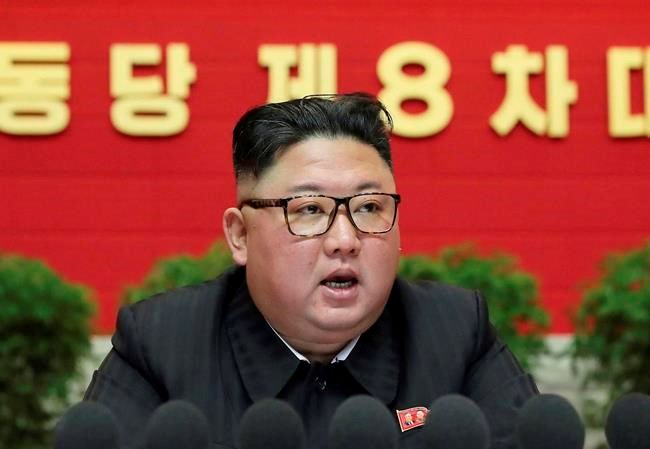SEOUL, Korea, Republic Of — North Korean leader Kim Jong Un threatened to expand his nuclear arsenal as he disclosed a list of high-tech weapons systems under development, saying the fate of relations with the United States depends on whether it abandons its hostile policy, state media reported Saturday.
Kim’s comments during a key meeting of the ruling party this week were seen as applying pressure on the incoming administration of President-elect Joe Biden, who has called Kim a “thug” and has criticized his summits with President Donald Trump.
The Korean Central News Agency quoted Kim as saying the “key to establishing new relations between (North Korea) and the United States is whether the United States withdraws its hostile policy.”
Kim said he won’t use his nuclear weapons first unless threatened. He also suggested he is open to dialogue if Washington is too, but stressed North Korea must further strengthen its military and nuclear capability to cope with intensifying U.S. hostility.
He again called the U.S. his country’s “main enemy.”
“Whoever takes office in the U.S., its basic nature and hostile policy will never change,” he said.
Biden, who will take office on Jan. 20, is unlikely to hold direct meetings with Kim unless the North Korean leader takes significant denuclearization steps.
Cheong Seong-Chang, a fellow at the Wilson Center’s Asia Program, said Kim’s speech showed he has no interests in denuclearization talks with Biden if he insists that working-level negotiations must sort out contentious issues first.
Kim didn’t cite any specific provocative U.S. actions. North Korea has previously called regular U.S. military drills with South Korea an invasion rehearsal, though the allies have repeatedly denied that.
The North Korean leader listed sophisticated weapons systems that he said were under development. They include a multi-warhead missile, underwater-launched nuclear missiles, solid-fueled long-range missiles and spy satellites. He said North Korea must also advance the precision attack capability on targets in the 15,000
“The reality is that we can achieve peace and prosperity on the Korean Peninsula when we constantly build up our national
It’s unclear if North Korea is capable of developing such systems. It’s one of the world’s most cloistered countries, and estimates on the exact status of its nuclear and missile programs vary widely. In 2018, the South Korean government said North Korea was estimated to have up to 60 nuclear weapons.
“What they want to tell the U.S. is we’re developing the new strategic weapons that you can see as the most intimidating. Do you want to come to the negotiating table?” Choi Kang,
KCNA said Kim’s comments were made during the ruling Workers’ Party congress, the first in five years, from Tuesday to Thursday. He spoke for nine hours, the agency said.
The congress, the party’s top decision-making body, is being held as Kim faces what appears to be the toughest moment of his nine-year rule due to blows to his already-fragile economy — pandemic-related border closings that have sharply reduced the North’s external trade, a spate of natural disasters last summer and U.S.-led sanctions.
During his opening-day speech, Kim called the difficulties the “worst-ever” and admitted his previous economic plans had failed. In his other comments reported Saturday, he called for building a stronger self-supporting economy and reducing reliance on imports under a new five-year development plan.
Since taking power in late 2011, Kim, who turned 37 on Friday, has pushed the so-called “byungjin” policy of simultaneously seeking economic growth and the expansion of his nuclear deterrent. After claiming to have achieved the ability to strike the U.S. mainland with nuclear weapons, Kim launched high-stakes summits Trump in 2018, but their diplomacy later fell apart due to wrangling over the sanctions the following year.
During this week’s speeches, Kim said North Korea will further boost ties with China, its biggest ally and economic lifeline but slammed South Korea for continuing the drills with the U.S. and introducing modern weapons.
South Korea’s Unification Ministry responded that it hopes for the early resumption of North Korea-U.S. talks, saying the inauguration of a new president in Washington can serve as a good chance to improve their ties.
“Kim’s speech foreshows the North Korean-U.S. relations won’t be smooth in the next four years with Biden in office,” said Nam Sung-wook, an expert on North Korea at Korea University in South Korea. “We won’t likely see big events and spectacles (like the Kim-Trump summits) for the time being.”
Hyung-Jin Kim, The Associated Press



